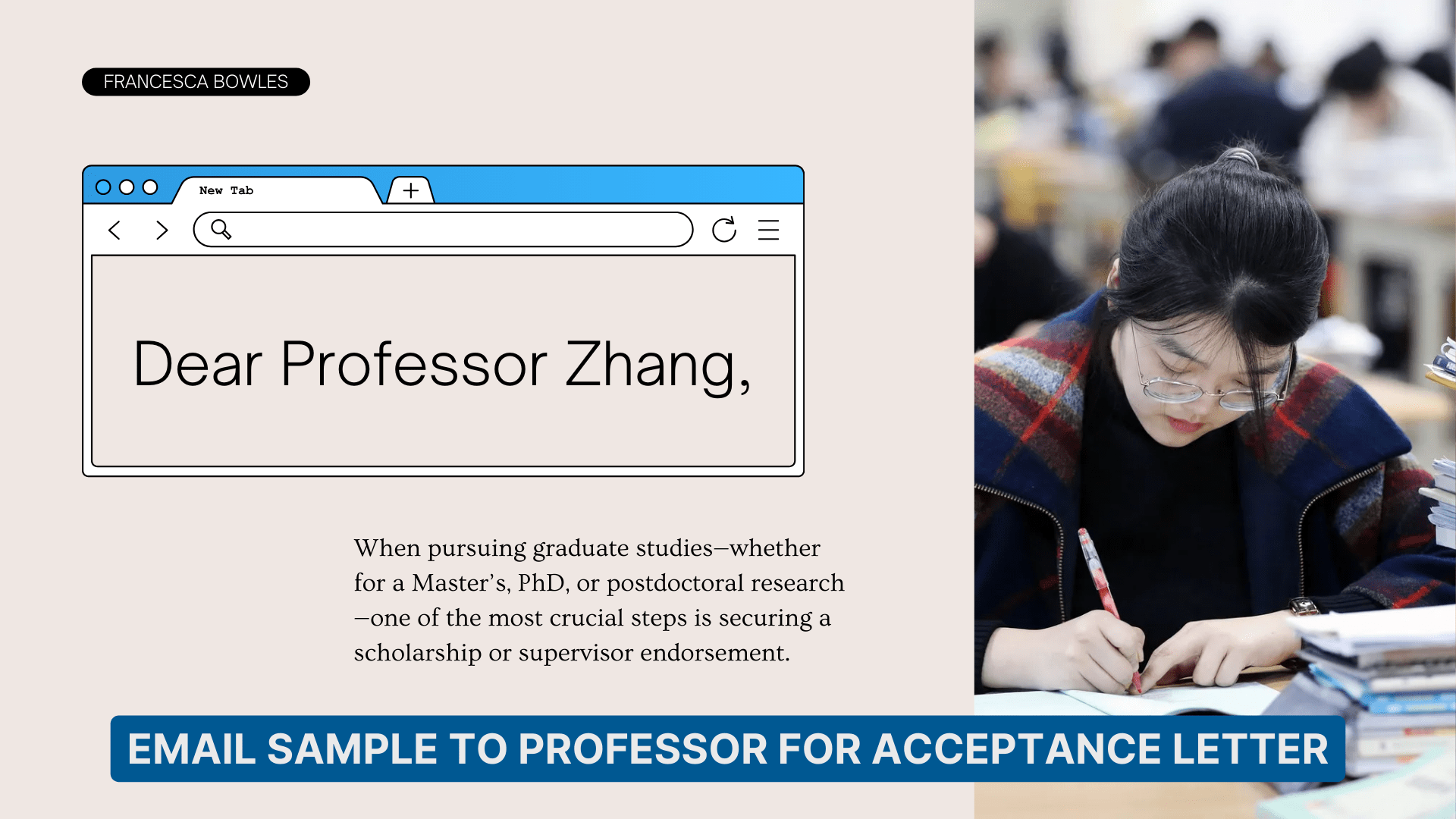When pursuing graduate studies—whether for a Master’s, PhD, or postdoctoral research—one of the most crucial steps is securing a scholarship or supervisor endorsement. A well-crafted email to a professor can make all the difference in whether you’re considered for funding, mentorship, or acceptance into a competitive academic program.
In this guide, we’ll walk you through every detail of how to write an email to a professor for an acceptance letter or scholarship consideration. This post includes original insights, actionable tips, and fresh email templates, all tailored for students aiming to secure opportunities abroad or within their home countries.
Table of Contents
-
Why Emailing a Professor Matters
-
When Should You Contact Professors?
-
How to Research the Right Professor
-
How to Write a Compelling Email
-
Subject Line
-
Introduction
-
Body Content
-
Closing Remarks
-
-
Tips for Increasing Your Response Rate
-
Follow-Up Etiquette
-
Example Email Templates
-
Common Mistakes to Avoid
-
Optimizing Your Email for Success
-
Final Thoughts and Call to Action
Why Emailing a Professor Matters
Emailing a professor for an acceptance letter isn’t just a formality—it’s often the first impression that determines whether you’ll be considered for a scholarship or assistantship. Professors receive many such emails, so yours needs to be professional, thoughtful, and well-researched.
Some scholarships, like the Chinese Government Scholarship (CSC) or DAAD Scholarships, often require applicants to obtain an acceptance letter or invitation letter from a university professor.
When Should You Contact Professors?
-
Before Applying: Reach out early—at least 2-3 months before scholarship deadlines.
-
After Identifying a Research Match: Ensure their work aligns with your interests.
-
Once You Have Your Materials Ready: Have your CV, academic transcripts, and research proposal prepared.
How to Research the Right Professor
Finding the right supervisor is the foundation of your application. Here’s how:
-
University Department Pages: Check faculty profiles.
-
Google Scholar: Explore recent papers to understand their research focus.
-
ResearchGate or Academia.edu: Follow their academic activities.
-
LinkedIn: Scan their professional background.
Pro tip: Make a list of 5–10 professors whose work aligns with your academic goals. Prioritize those currently supervising graduate students or publishing actively in your field.
How to Write a Compelling Email
Let’s break down the components of an effective email.
1. Subject Line
Make it specific and clear. Avoid vague subject lines like “Hello” or “Application Inquiry.”
Examples:
-
“Prospective PhD Student Interested in Your Research on Environmental Microbiology”
-
“Request for Acceptance Letter for CSC Scholarship 2025 – MSc in Data Science”
2. Introduction
This is where you grab attention.
Example:
My name is Amina Yusuf, and I hold a BSc in Biochemistry from the University of Ghana. I have a keen interest in molecular genetics and was deeply inspired by your recent paper on RNA editing in plant mitochondria.
3. Body Content
This section should be no more than two short paragraphs. Be clear, respectful, and specific.
Include:
-
Your academic background and achievements.
-
Research experience or publications (if any).
-
Why you are reaching out.
-
How their research aligns with yours.
Example:
During my undergraduate thesis, I investigated gene expression patterns in drought-resistant maize, and I’m now preparing a manuscript for publication. Your work on genetic adaptation in crop species strongly aligns with my goals for postgraduate research.
I am writing to inquire whether you are accepting new MSc students for the upcoming academic year, and if you would be willing to provide a letter of acceptance to support my CSC Scholarship application.
4. Closing Remarks
Keep it courteous and professional.
Example:
I have attached my CV, academic transcript, and a brief research proposal for your consideration. Thank you for your time, and I look forward to the opportunity to discuss potential collaboration with you.
Signature:
Sincerely,
Amina Yusuf
aminayusuf@email.com
LinkedIn: linkedin.com/in/aminayusuf
Tips for Increasing Your Response Rate
-
Personalize every email: Never send a generic message to multiple professors.
-
Keep it concise: Professors are busy—respect their time.
-
Use formal titles: Always address them as Dr. or Professor.
-
Avoid slang or casual language.
-
Proofread before sending: Use tools like Grammarly to check grammar and tone.
Follow-Up Etiquette
If the professor doesn’t reply within 10–14 days, you can send a polite follow-up.
Follow-up Email Example:
Dear Professor Chen,
I hope this message finds you well. I am writing to follow up on my previous email sent on March 25 regarding a potential MSc position in your lab. I remain very interested in your work and would appreciate any updates regarding supervision or acceptance letters for scholarship applications.
Thank you once again for your time.
Best regards,
Amina Yusuf
Email Template Examples
Email Sample for PhD Acceptance Letter Request
Subject: Prospective PhD Student – Request for Supervision and Acceptance Letter
Dear Professor Li,
I hope you are doing well. My name is Samuel Mensah, and I recently completed a Master’s degree in Environmental Science from the University of Cape Coast, Ghana. I am highly interested in your research on climate-smart agriculture, particularly your 2023 publication in Nature Sustainability.
I am writing to express my interest in pursuing a PhD in your lab at Zhejiang University under your guidance. I aim to apply for the CSC Scholarship and understand that an acceptance letter is required as part of the application.
I have attached my CV, transcripts, and a brief research proposal for your review. I would be honored to join your team and contribute meaningfully to your ongoing projects.
Thank you for your consideration.
Best regards,
Samuel Mensah
[email protected]
Email Sample for Master’s Acceptance Letter Request
Subject: Master’s Program Supervision Request for CSC Scholarship – Data Analytics
Dear Professor Zhang,
My name is Lydia Boateng, a BSc Statistics graduate from Kwame Nkrumah University of Science and Technology. I’m reaching out to inquire about the possibility of joining your research group as a Master’s student in Data Analytics at Shanghai Jiao Tong University.
I am planning to apply for the 2025 CSC Scholarship and understand the need for an acceptance letter. Your research on machine learning for healthcare applications aligns perfectly with my career interests.
Kindly find attached my CV and a short research proposal for your consideration. I would be grateful for the opportunity to collaborate with you.
Looking forward to your response.
Sincerely,
Lydia Boateng
[email protected]
Common Mistakes to Avoid
-
Mass emailing without personalization.
-
Being too vague about your interest or background.
-
Failing to attach relevant documents like your CV or proposal.
-
Using informal greetings such as “Hey” or “Hi there”.
-
Overselling or writing overly long emails.
Optimizing Your Email for Scholarship Success
To maximize the impact of your email:
-
Use strong keywords in your subject and first sentence (e.g., “CSC Scholarship,” “PhD Supervision,” “Climate Policy”).
-
Attach properly named files like
CV_LydiaBoateng.pdforProposal_SamuelMensah.docx. -
Ensure consistency in tone and align your interests with the professor’s research.
Final Thoughts and Call to Action
Securing an acceptance letter from a professor is often the first step toward landing a fully funded scholarship. By following the strategies in this guide—researching properly, personalizing your approach, and crafting a thoughtful, well-organized email—you significantly increase your chances of success.
Start now by:
-
Creating a shortlist of potential professors.
-
Drafting a professional email tailored to each one.
-
Sending your emails at least 2–3 months before application deadlines.
-
Following up politely if needed.
Don’t wait—start crafting your future today.
For more scholarship tips, templates, and strategies, subscribe to our newsletter or explore our [Scholarship Application Toolkit].

